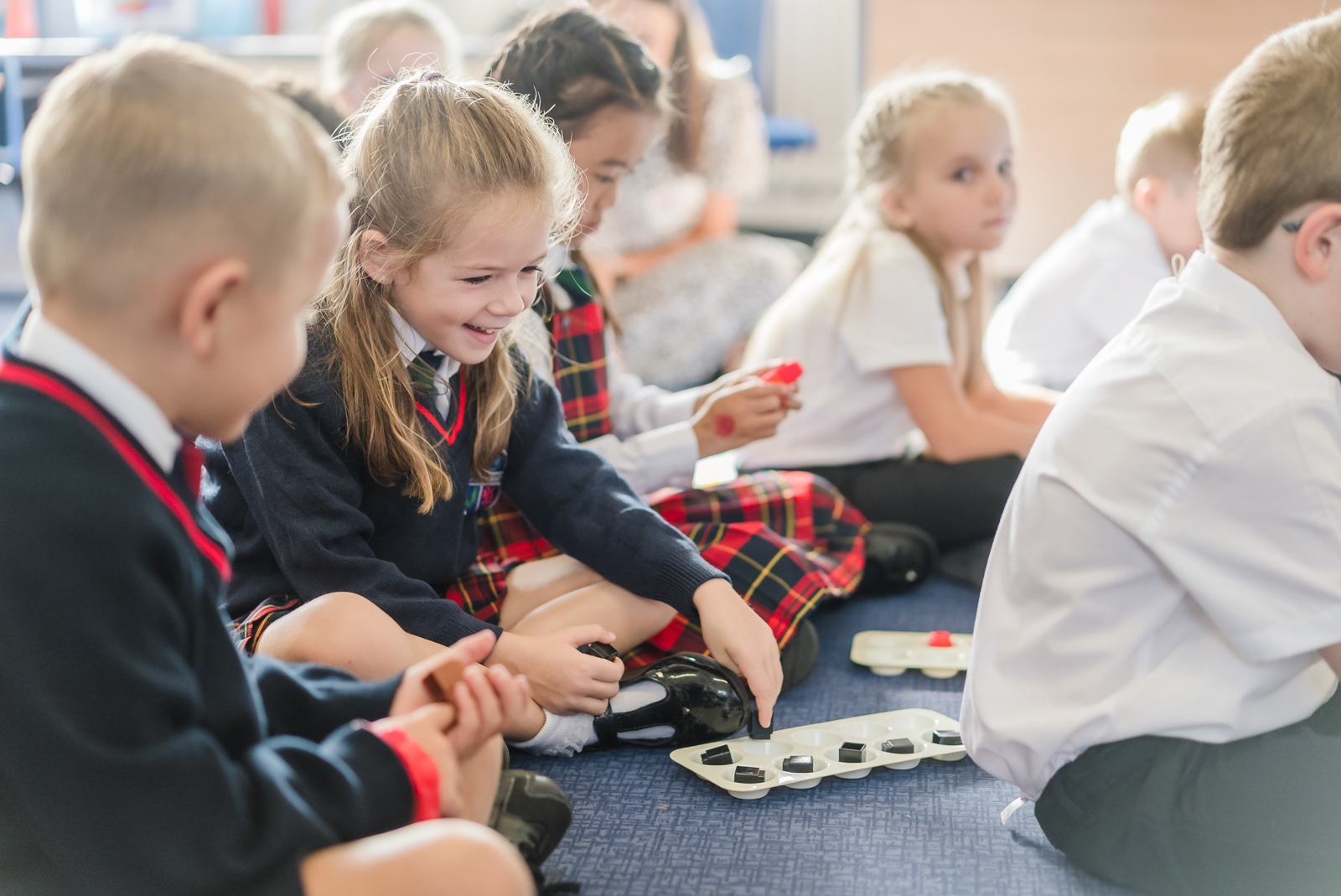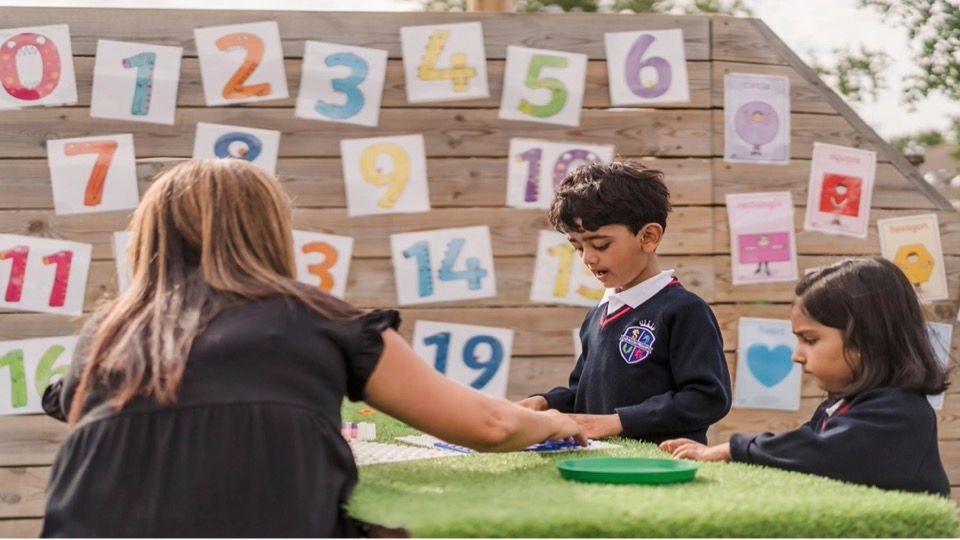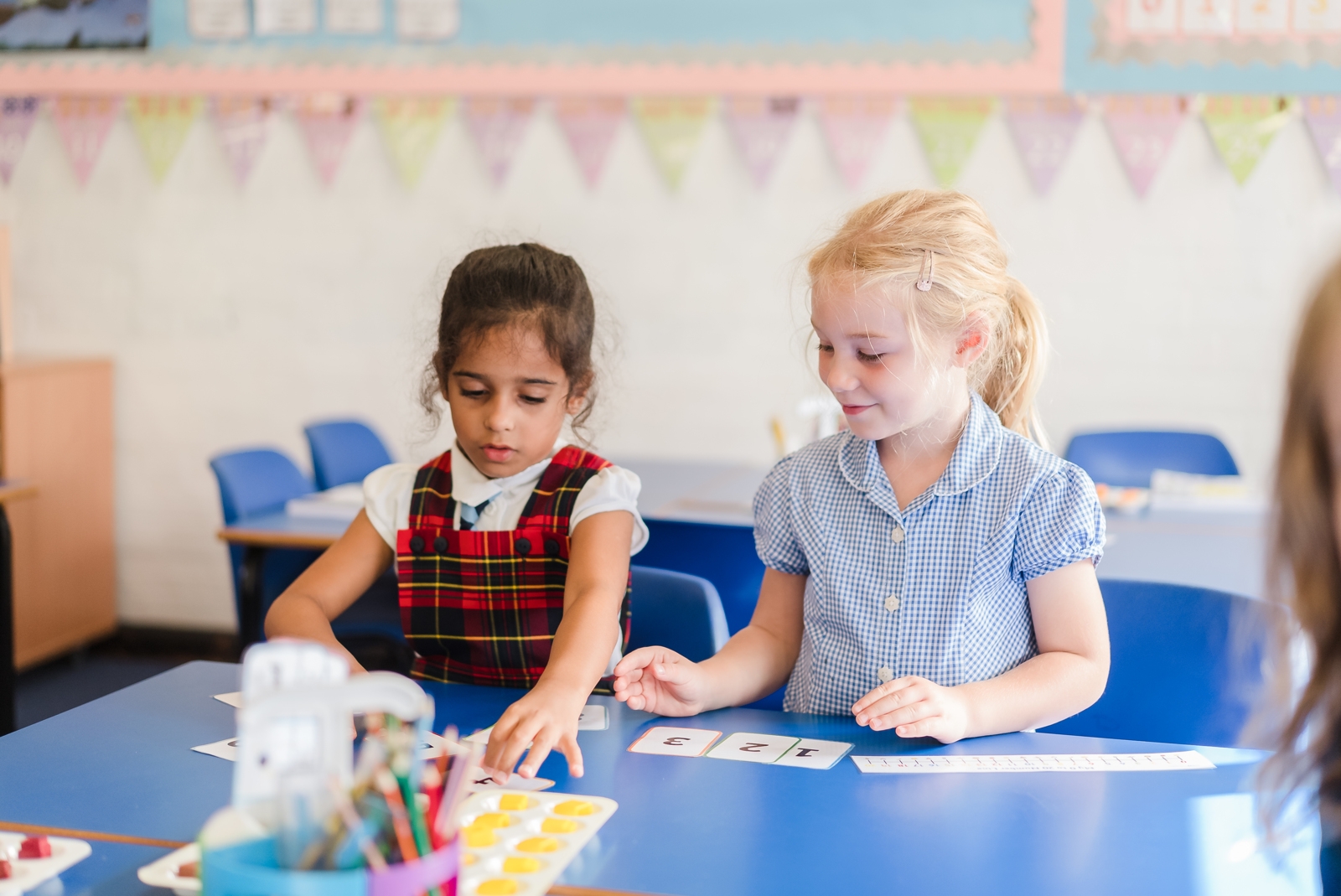Matt Ashby on why 100% of his EAL learners passed maths SATs
We're seeing children shouting out ‘yes’ when it’s their time to do maths.
Matt Ashby tells the story about a Year 4 class he was teaching, back when he first started using Maths — No Problem! The topic of the lesson was fractions. The task: subtract ⅖ from 1⅕.
I was looking around the room. It was just puzzled faces. People scratching their heads. Bewilderment across the whole cohort of children.
Then the class started going through the lesson. It started with a character who tells a story about using some water to make a drink. An illustration shows water in two beakers. One of the beakers is full. The other is one-fifth full. The character says she needs two-fifths of a litre of water to make the drink.
In the classroom, Matt and the children poured liquid into two beakers, just as in the textbook. At the same time, he drew a bar model on the board to represent the liquid — two bars, each divided into fifths.

Then we started getting to the point of ‘Right, I need to pour out one fifth.’ We also used the bar model at the same time. So, we crossed out one fifth on our bar model. And then we had another fifth that we had to pour out. Then as soon as we started to pour out and cross out, a sea of hands were in the air just sort of bursting with excitement to basically call out what the answer was.
From that day on, he said, he saw the benefit of the Concrete-Pictorial-Abstract approach, the theory from Jerome Bruner that forms one of the cornerstones of maths mastery that leads students to a deeper conceptual understanding. “Actually doing it physically just opens up their eyes and shows them maths is all around them in the real world. Once children see that it's something they can use, then it builds more engagement in them.”
Editor’s note: Want to hear more about Matt Ashby and Aragon? Keep an ear out next week when we release a new episode of the School of School podcast with Matt as special guest.
It’s been several years since Matt and Aragon began using Maths — No Problem! The improvement has been “phenomenal”. In terms of maths results, the school has gone from the 24th percentile of schools in England to the sixth percentile two years ago, then to the fifth percentile last year.
The latest SATs results show that 94.8% of the children at Aragon attained the “expected level,” versus 73% nationally, and 36.4% reached “greater depth,” versus 24% nationally.
According to Matt, one of the reasons more than a third of the cohort reached greater depth is that problem-solving and reasoning is “drip-fed” into every Maths — No Problem! lesson, compared with other programmes, where the focus is on fluency and rote learning, and then problem-solving comes only at the end.
One of Aragon’s most impressive results is that 100% of English as an Additional Language (EAL) pupils passed the maths SATs. Matt says the focus on using concrete materials has made a big difference. “The special education needs children have benefited probably the most because it helps them to see with all the different manipulatives in front of them.”
In addition to using the concrete resources, it has helped them to have bar models that they can see visually and the textbooks which allow them to refer back to the master sections, along with cards that show how the different characters solved various problems. “They call them their friends, the little character cards, ‘this is how my friends have completed it. This is how I'm going to complete it.’ It gives them that stability to be able to say, ‘Okay, let's look at it again.’ And they've got something they can refer back to.”
Transform Your Maths Assessment
Insights — our online assessment tool — gives you instant, powerful data to identify gaps and improve results.

Vitally important CPD
It’s well-known that a school that implements Maths — No Problem! and is committed to seeing it through over several years will see results. But each school goes about it differently. The programme must be adjusted to fit the needs of the particular school.
Matt and his colleagues have looked at the key underpinnings of mastery. He’s done plenty of training with staff on the so-called Five Big Ideas, but if a teacher doesn’t have a maths background, then ideas like variation may be harder to grasp. While Maths — No Problem! embeds variation throughout the lessons, Matt still takes the time to show teachers why the design of the structure, the sequence of learning, is based on intelligent practice. “Being able to spell that out to my staff through training has really been a big bonus for how they've understood and grasped the concept of the scheme.”
Once a term, he holds a staff meeting to delve into a topic that needs improvement, for example focusing on stem sentences to make sure the oracy is there for the children. Journalling, another pillar of mastery, is an area where extra in-house training has brought good results. “The children journal their ideas, so we did a big session on stem sentences using the different subjects. ‘What could we do to journal this? What would be a good structure? Any generalizations we can pick up from it?’”
In addition, when the school first implemented the programme, a few days of whole-school training with the legendary Singapore maths trainer Ban Har was “vitally important because it allowed everyone to be singing from the same hymn sheet.”

Origins of a career
Matt first became interested in teaching when he was around 13 or 14. His mother worked for a charity that helped pre-school children. One of the young girls was non-verbal. She wouldn’t talk to anyone including her parents. Over the course of several weeks, Matt shared a story with her, making it progressively more humorous. “Then eventually towards the end of the six to eight weeks, she started to communicate. I just thought that was obviously quite a big impact that I'd had on somebody. It was just really rewarding.”
He was always passionate about maths, and as computing lead at a previous school, felt there were many cross-curricular links with maths. At Aragon, an inner-city school of about 600 pupils in Merton, a borough in southwest London, he shadowed the former maths lead as part of the transition process, and took over in that position six years ago
He always enjoyed the fact that there’s a right and a wrong answer in maths, but since using Maths — No Problem! he says his understanding of the subject has become even stronger. “Just through looking at Bruner’s approach in terms of building up in the small steps has been really beneficial.”
His understanding of what mastery is has also changed. He used to think it meant answering questions quickly and with a high level of accuracy. Now he sees it more as being fluent between different strands of mathematics, where a pupil can solve problems by journaling their ideas in multiple different ways, they can show the variation within a problem by being able to solve it on a number line or solving it using a different representation. “That to me now is what mastery is. It's just changed my whole perception.”

Small steps
Breaking learning into small, manageable steps, where a teacher provides structured support until the learner can complete tasks independently, is known as scaffolding, and it’s an important aspect of mastery. Another is the use of the spiral curriculum, which refers to revisiting key concepts at increasing levels of complexity over time, reinforcing learning gradually.
The use of these mastery ideas is leading to a broader shift. Matt says earlier in his career, at a different school, he noticed a knock-on effect where maths insecurities were passed on from parents to their children. “Now since using Maths — No Problem! we're seeing children shouting out ‘Yes!’ when it's time to do maths.”
In a recent “pupil voice” session, Matt says 50% of the children put maths in their top three subjects, even when subjects like art and PE were included in the choices. “That shows the impact that Maths — No Problem! has had on our school because it's just completely reversed the structure and their interpretation of what they feel maths is.”
His headteacher also did some pupil voice that showed all the children she spoke to — which she wasn't expecting — said they all loved the structure of the lessons, where they started with a problem, then worked through examples, often using manipulatives. “All of them said they enjoyed it. And she thought, ‘surely they thought it would be too repetitive, as they are doing the same thing.’ But they just love the structure of it because they know where they're going with it. They know if they don't get it, that's all right because we're going to have some worked examples next. It's just improved their motivation for the subject.”
Learn more:
Proven revision strategies to support students and staff during SATs
An introduction to assessment and classroom learning
Ross Deans and the importance of framing maths as stories (Part 1)
